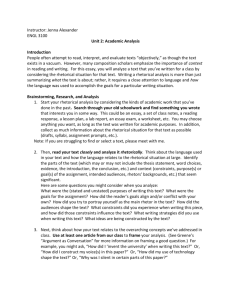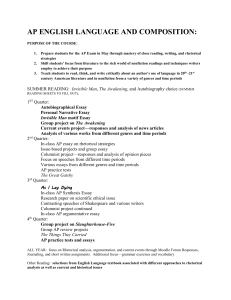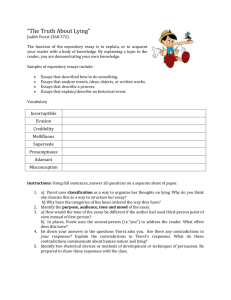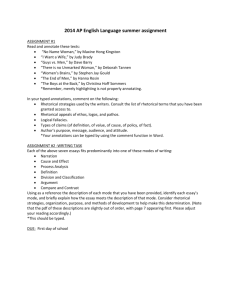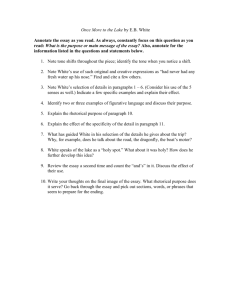Course syllabus - Magoffin County Schools
advertisement
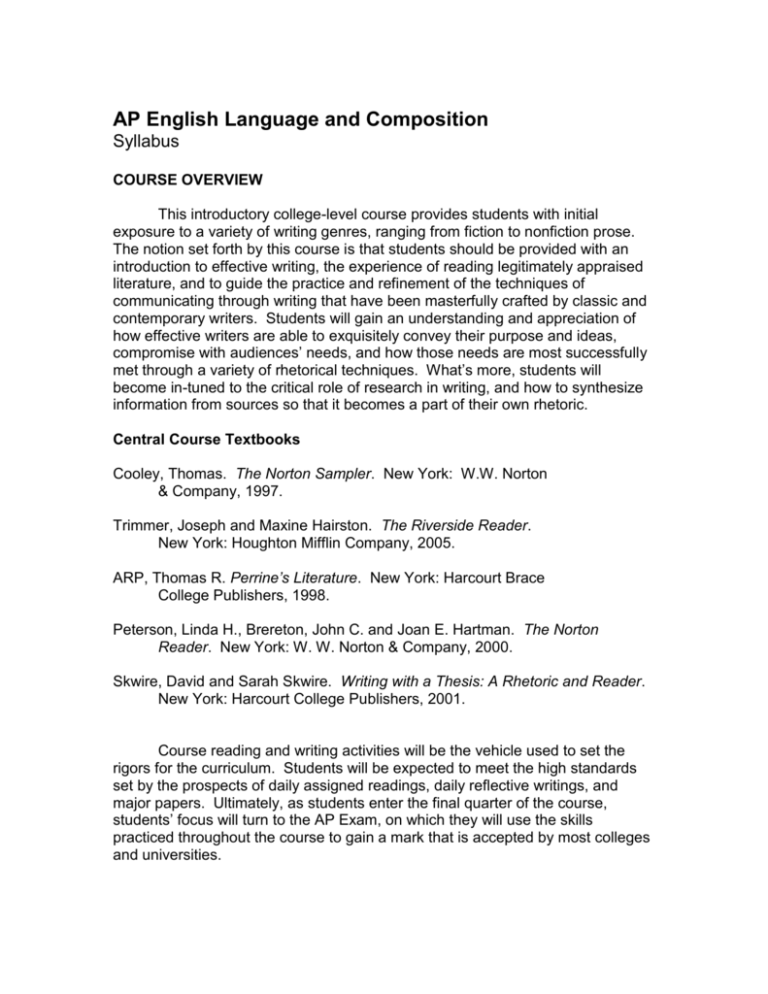
AP English Language and Composition Syllabus COURSE OVERVIEW This introductory college-level course provides students with initial exposure to a variety of writing genres, ranging from fiction to nonfiction prose. The notion set forth by this course is that students should be provided with an introduction to effective writing, the experience of reading legitimately appraised literature, and to guide the practice and refinement of the techniques of communicating through writing that have been masterfully crafted by classic and contemporary writers. Students will gain an understanding and appreciation of how effective writers are able to exquisitely convey their purpose and ideas, compromise with audiences’ needs, and how those needs are most successfully met through a variety of rhetorical techniques. What’s more, students will become in-tuned to the critical role of research in writing, and how to synthesize information from sources so that it becomes a part of their own rhetoric. Central Course Textbooks Cooley, Thomas. The Norton Sampler. New York: W.W. Norton & Company, 1997. Trimmer, Joseph and Maxine Hairston. The Riverside Reader. New York: Houghton Mifflin Company, 2005. ARP, Thomas R. Perrine’s Literature. New York: Harcourt Brace College Publishers, 1998. Peterson, Linda H., Brereton, John C. and Joan E. Hartman. The Norton Reader. New York: W. W. Norton & Company, 2000. Skwire, David and Sarah Skwire. Writing with a Thesis: A Rhetoric and Reader. New York: Harcourt College Publishers, 2001. Course reading and writing activities will be the vehicle used to set the rigors for the curriculum. Students will be expected to meet the high standards set by the prospects of daily assigned readings, daily reflective writings, and major papers. Ultimately, as students enter the final quarter of the course, students’ focus will turn to the AP Exam, on which they will use the skills practiced throughout the course to gain a mark that is accepted by most colleges and universities. This course is constructed in accordance with the guidelines described in the AP English Course Description [c1]. COURSE PLANNER First Quarter: Course Orientation, Introduction to Close Reading, Understanding the Thesis, Understanding Comparison, Introduction to Rhetorical Awareness The course begins with a follow-up from the summer assignment, which consists of reading J.D. Salinger’s novel The Catcher in the Rye and Frank McCourt’s memoir Angela’s Ashes. During the summer, students were required to write reflectively in a journal concerning their views of the book, what the writer’s purpose was, how they conveyed this purpose, and whether or not they were successful [c4]. No prior introduction to rhetoric was given before this assignment. Rather, students were to use their prior knowledge and ideas to discuss such topics. Students were also given reading questions that range from explicit to the implicit level of questioning to guide them and to help me make certain that students are reading. Questions were given deadlines for being submitted. On their return to school, students will take a multiple choice test that assesses their ability to analyze character, and theme. Students will proceed from this point to sharing their reflective journals. This will serve as their initiation to shared writings, which will be an integral part of this course. Students will also begin a study of writing with a thesis by examining the first section of the book Writing with a Thesis: A Rhetoric and Reader. Students will examine what is known as “The Persuasive Principle.” Students will complete assignments and discussion on the differences between general subjects and limited subjects, what a thesis is and isn’t, what a good thesis is, and the thesis at work in the paper. Students will also, within this first section, study writer’s purpose and how to identify it and audience awareness. Major Paper #1: After looking at the concept of a coming-of-age story, students will draft an essay in which they discuss how the features of a coming-of-age story are apparent in The Catcher in the Rye and Angela’s Ashes[c2]. Students will also formulate an idea of which genre served the writer’s purpose best in crafting this type of story, a novel or memoir. Students will look at the advantages and disadvantages of each genre. This essay will also reflect upon students’ abilities to develop a thesis and their ability to analyze writing for purpose, audience, and content. Students are to highlight passages from both works that convey the ideas for which they are trying to provide support. Students may also use Writing with a Thesis: A Rhetoric and Reader for reference. Focus on two rhetorical modes for writing will also become a part of the first quarter. Students will examine writings under the modes of (1) narration and (2) comparison and contrast [c6]. Emphasis on close reading and annotation will be the focus. Students will examine essays by such authors as Langston Hughes, Nancy Mairs, E.B. White, Eudora Welty, Sister Helen Prejean, George Orwell, Mark Twain, Paco Underhill, Anne Roiphe, and others. These writers’ essays can be found in The Norton Reader, The Riverside Reader, and Writing with a Thesis: A Rhetoric and Reader. A reflective journal will be maintained during the study of these modes [c4]. Major Paper #2: After reading a collection of essays under the modes of narration and comparison and contrast, students will write their own essay that adopts one of these modes of writing [c6]. Students will be asked to rely upon the skills demonstrated in the essays of the professional writers. For narration, students’ essays will be expected to have an identifiable purpose, an equilibrium between reflection and story-telling, and sensitivity to pacing and description. For comparison and contrast, students will be expected to choose either a fanciful or strict comparison of two things, people, or concepts. Students are to rely upon their creativity concerning whether or not to write solely within this mode or to compare it with narration. Conferencing for the essay will be scheduled for three separate occasions[c3, c10]. Following these conferences, students are to revise, prepare, and submit the final versions of their essays. Students are to submit a check sheet of rhetorical techniques used in their paper. This essay will also involve annotation. Students are required to use a minimum of 5 sources in their paper[c8]. Documentation of these sources will be based upon MLA style[c9]. At the end of the first quarter, students will practice their first timed essay. The writing prompt of choice will highlight personal essays. The question involves an excerpt from Eudora Welty’s One Writer’s Beginnings. Students are asked to analyze the rhetorical techniques that Welty uses to convey how her childhood experiences lead to her development as a writer. Second Quarter: Analyzing Tone, More Rhetorical Awareness, Description, Research and Annotation During the second quarter, students will be exposed to a large list of vocabulary that can be employed for describing tone. One of the priorities of this quarter will be to help students distinguish between attitude and tone since they do not always coincide. To begin understanding tone, students will work through a unit in the textbook Perrine’s Literature. Most of the selections that students will be assigned are poetry. Students will examine the poetry of such poets as Emily Dickinson, Alfred, Lord Tennyson, Richard Eberhart, Robert Frost, and others. Students will learn how the elements of diction, connotation, figurative language, subject, and occasion all must be considered to determine tone. Students will be required to complete a series of quizzes that will assess their knowledge of the meanings of words that they most certainly never use, but could appear on the AP test. Major Paper #3: Students will select a poet and complete research on his/her life and time period for writing. After studying their poems, students will use a select few that they believe convey ideas and attitudes about the time period for writing and about the poet’s life. Students are to include a discussion of tone within this paper, though tone does not have to be a part of their thesis statement. Students are required to cite a minimum of five sources in this paper, using MLA style [c8, c9]. In their conferences with me, students are required to submit pencil-in-hand readings of the poems, showing how they considered diction, connotation, and figurative language while analyzing the poems [c10]. A pencil-in-hand read will consists of photocopies of the poems with writings and comments in the margins, circled words, and other markings that represent that they worked to draw a full analysis. The paper requires a bibliography page that cites the sources in MLA style. Students will transition from Major Paper #3 into an introduction to the rhetorical mode of description. Using the texts The Riverside Reader and The Norton Reader, and The Norton Sampler, students will make use of their reflection notebooks while reading the works of such authors as Bevery Dipo, Joan Didion, Lars Eighner, Thomas Jefferson, Virginia Woolf, and more. While studying these selections, students will also engage in the study of Nathaniel Hawthorne’s The Scarlet Letter. The decision to turn to this well-known classic is due to Hawthorne’s use of rich, flamboyant language, and elaborate description. An exam will be given over this novel that will involve the close reading of particular passages that highlight the skills that fall under the mode of narration and description. Major Paper #4: What’s more, students will continue to practice the skills of research by looking into the psychoanalytical aspect of the characters of Dimmesdale and Chillingworth. Using a minimum of three sources, students will complete research on the id, ego, and superego and explain in an essay at what points each aspect of the personality was most profound in each character [c8]. During conferencing and with submission of their final draft, students will turn in a character bone structure. A character bone structure is different from typical character sketches. Students are to complete information under the headings: Physiological, Sociological, and Psychological. The information that students provide must be quoted from the book. This addition to their essay enhances their practice with close reading and analysis. Of course, students will continue to be assessed on their ability to write with a purpose, maintaining unity and coherency throughout while breaking the barriers of a standard 5-paragraph essay. Students again will submit a rhetorical technique check sheet with their final draft. Major Paper #5: Students will draw upon the study of portraits to draft an essay that falls under the rhetorical mode of description [c2]. Using excerpts from the book Lincoln’s Melancholy: How Depression Challenged a President and Fueled His Greatness, students will learn about the mental suffering that Lincoln endured far before his presidency and during his presidency. Students will study portraits of Lincoln and their dates from the time that he looked young and robust to when he looked old, tired, and careworn. Students will be required to demonstrate their ability to write descriptively, particularly showing sensitivity to spatial order while also discussing the issues that Lincoln was dealing with at the time the portrait was made [c7]. The second quarter will culminate with an AP writing prompt that focuses on analyzing tone. Students will look at an excerpt from Nancy Mairs’ essay “On Being a Cripple” and analyze the elements involved in determining the writer’s tone. Third Quarter: More Rhetorical Awareness, Definition, Persuasion and Argument, Speeches The third quarter will begin with the study of two more rhetorical modes: (1) Definition and (2) Persuasion. Students will study writings and speeches from writers such as Martin Luther King, Jr., Malcolm X, Barbara Kingsolver, Harold Bloom, and more. A substantial amount of this quarter will be taken up by studying speeches and their rhetorical techniques. Students will look at speeches that have gained monumental fame, such as the Gettysburg address, but will also look at contemporary speeches, such as this year’s State of the Union address. Students will be required to submit check sheets of the rhetorical techniques in these speeches. They will also analyze how rhetorical appeals are used in speeches. Major Paper #6: Students are to craft a speech that deals with a social problem in our community or one that is considered global. Students will be encouraged not to deal with issues that have been exhausted in debate such as abortion and drugs. A minimum of 5 sources must be used to help develop this speech and a works cited must be submitted using MLA style [c8, c9]. For this writing, students will monitor what is included in their work by using a check sheet for rhetorical techniques and rhetorical appeal. The content of their speech, the validity of their sources, and help with documentation will be met in three separate conferences [c10]. Major Paper #7: The fiction under focus this quarter will be F. Scott Fitzgerald’s The Great Gatsby and Arthur Miller’s Death of a Salesman. Under discussion will be the complexity of the American Dream. Students will be required to use their reflection notebook during the readings of both works. Students’ will be required to research the time period for each book and learn about its culture, economics, and politics. Students will also be required to read “The Tragedy of the Common Man” by Arthur Miller, in which Miller justifies why the common man is more appropriate for tragedy than the nobles that are often read about in Shakespeare’s tragedies. Students’ papers will take on an argumentative tone in determining which book best conveys the complexities of the American Dream and will also use a particular passage from Miller’s essay to fuel their argument [c5]. Students will be required to document the sources in their paper using MLA style [c9]. Consultation with me will be in three parts. (1) a check on sources and documentation assistance (2) a check on purpose and content (3) answer any questions for the students before the final draft is submitted[c10]. Fourth Quarter: Preparing for the AP exam, Synthesis Essay, Refining Close Reading Skills, Drilling the AP Glossary The final quarter will begin with a series of essays that are associated with the environment. Students will read these essays to gather notions on how the writers feel about different aspects of the environment, where the writers agree and where they differ. Students will think about what the environment involves and the different ways that people respond to it. Students will consider the value and vitality of the environment. Students will examine the essays of writers such as Wendell Berry’s “Conservation is Good Work, Arthur C. Clark’s “The Star”, Andre Dubus’s “Digging”, Mark Twain’s “Two Views of the River” and more. Major Paper # 8: For this assignment, students are to write a researched argument paper that requires them to draw upon sources that can be used to refute or support a passage that raises debate about the environment [c5]. Students are to look at the essays read in this quarter as sources but are to also turn to individual sources that deem worthy and legitimate for use in this paper, such as periodical and web sites. Students will be advised to read all sources with careful consideration before developing any controlling statements that will reflect their stance on the issue. Students are to conference with me about their chosen sources and their stance for the paper. In a final conference, students are to have final concerns addressed and receive assistance with documentation of sources using MLA style. Students will also be expected to continue to refine their rhetorical skills in this paper. As the quarter draws to a close, and the exam approaches, students will continue to look in depth at a glossary of AP terms and will undergo a series of practice multiple-choice exams from AP study guides and released items. Students will also complete a timed writing during each of the final 5 weeks before the exam. Students will be consulted with about their approach to these writings. Student Evaluation Students’ evaluation will be based on major papers, homework, and quality of class participation. Students will receive scores on the following: Major Papers (Numbered Score) Reflective Journal Entries (participation and effort) AP Writing Prompts (Numbered Score) Exams (Numbered Score) Major Papers Novel Exams In-Class Writing Multiple Choice Participation 55 percent 10 percent 15 percent 3 percent 17 percent The usual A-B-C-D-F system is used to grade student work each quarter. Students will receive justification for grading in conferences. Students will be permitted to improve a score on a major paper at the teacher’s discretion.
